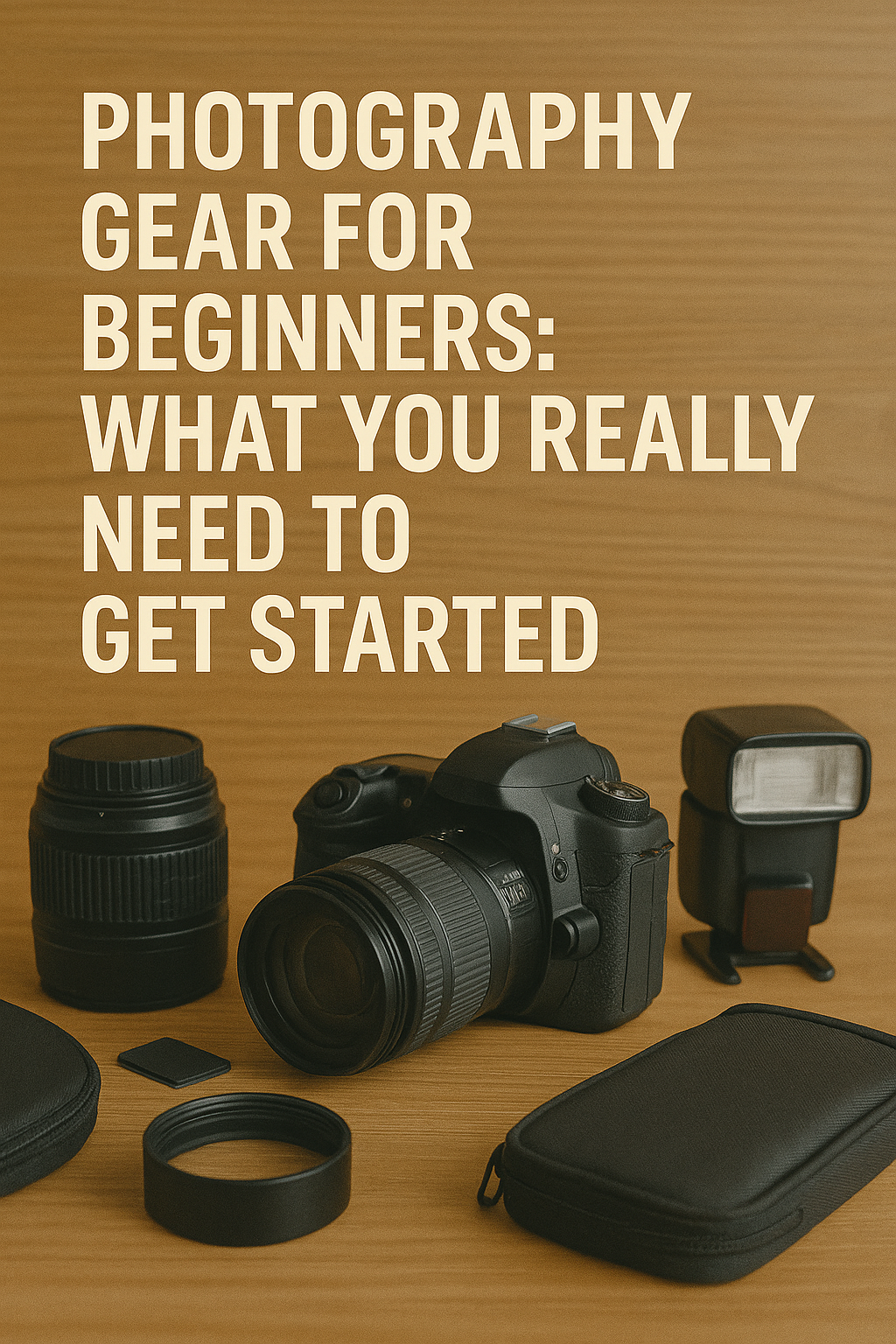Starting photography often comes with the temptation to buy the latest camera, multiple lenses, and all kinds of accessories. But the truth is — you don’t need a huge investment to take amazing photos. What you really need is the right gear for your goals, and the knowledge to use it effectively.
This beginner-focused guide will walk you through essential photography equipment: what you need, what you can skip (for now), and how to build your kit the smart way — whether you’re shooting portraits, landscapes, products, or everyday life.
1. Start With the Camera You Already Have
Before you buy anything, take time to learn with what you already own.
Options:
- Smartphone: Modern smartphones (iPhone, Samsung, Pixel, etc.) have powerful cameras. Great for learning composition, light, and storytelling.
- Point-and-Shoot Cameras: Simple, compact, and better image quality than a phone in many cases.
- DSLR or Mirrorless (if you already own one): Explore the manual settings and practice shooting in different modes.
📌 Tip: Your skills matter more than your gear. A great photographer with a basic camera will always outperform a beginner with a $5000 setup.
2. Choosing Your First Real Camera
When you’re ready to buy a dedicated camera, the most common options are:
📸 DSLR (Digital Single-Lens Reflex):
- Trusted, reliable, slightly bulkier.
- Optical viewfinder, long battery life.
- Great choices:
- Canon EOS Rebel T8i
- Nikon D5600
📷 Mirrorless:
- Lightweight, compact, newer technology.
- Electronic viewfinder, faster autofocus.
- Great choices:
- Sony ZV-E10
- Canon EOS R50
- Fujifilm X-S10
🎯 Choose based on:
- Your budget
- What you like to shoot
- Availability of lenses and accessories
3. The One Lens Every Beginner Should Own
When starting out, you don’t need a bag full of lenses. You need one versatile, high-quality lens — the “nifty fifty.”
📌 50mm f/1.8 Lens:
- Affordable
- Great for portraits, food, everyday use
- Sharp images with beautiful background blur (bokeh)
- Lightweight and excellent in low light
Available for Canon, Nikon, Sony, Fujifilm, and others.
If your camera has a crop sensor, a 35mm lens is a better equivalent.
4. Memory Cards and Storage
Your camera needs somewhere to store photos. Choose a high-speed, high-capacity memory card:
- At least 32GB or 64GB for starters
- Class 10 or UHS-I/UHS-II for fast performance
- Brands: SanDisk, Lexar, Kingston
💾 Also invest in external storage (hard drives or cloud services) to back up your work regularly.
5. Tripods: Stability for Sharp Shots
A tripod is one of the best accessories for any photographer.
Why use a tripod:
- Shoot in low light without blur
- Long exposure photography (e.g., waterfalls, night shots)
- Self-portraits and group photos
- Stable video recording
What to look for:
- Lightweight and portable
- Sturdy build (aluminum or carbon fiber)
- Ball head for easy angle adjustment
Recommended for beginners:
- Manfrotto Compact Action
- UBeesize Tripod (budget-friendly)
- Joby GorillaPod (for smartphones or vlogging)
6. Must-Have Accessories for Beginners
Once you’ve got your camera and lens, here are useful extras:
🧼 Lens Cleaning Kit
- Lens cloth, brush, and blower
- Keeps your images dust-free and sharp
🎒 Camera Bag
- Protects your gear on the go
- Choose one with padded compartments
🔋 Extra Batteries
- One battery is never enough, especially on long shoots
💡 Reflector
- Affordable way to bounce natural light for portraits or product shots
📲 Smartphone Tripod or Mount
- Ideal if you shoot with your phone or vlog
7. Editing Software
Even simple edits can take your photos from good to great.
Recommended options:
- Adobe Lightroom (desktop & mobile): Professional, easy to learn, non-destructive editing
- Snapseed: Free, powerful mobile app
- VSCO: Filters and basic editing with a clean UI
- Canva (for social media posts)
Start with Lightroom Mobile (free with limitations) and learn to adjust:
- Exposure
- Contrast
- White balance
- Sharpness
- Saturation
8. Optional Gear You Can Skip (For Now)
You don’t need everything at once. Here’s what you can safely postpone:
❌ Multiple Lenses
Stick with one versatile lens until you outgrow it.
❌ Flash Units
Natural light is more than enough when starting.
❌ Filters (ND, polarizers)
Useful later, but not essential for learning basics.
❌ Drones
Fun, but expensive and complex. Focus on ground-level photography first.
9. Budgeting for Photography Gear
You don’t need to break the bank. Here’s a smart way to allocate your money:
| Budget | Suggested Setup |
|---|---|
| $0 | Smartphone + free apps |
| $200–$500 | Used DSLR/Mirrorless + kit lens + tripod |
| $500–$1000 | Mirrorless camera + 50mm lens + tripod + bag + editing software |
| $1000+ | Camera body + 2 lenses + accessories + Lightroom subscription |
Buy used or refurbished from trusted sellers (like B&H, KEH, or Adorama) to save.
10. What Matters Most: Practice, Not Purchases
Great gear helps — but it’s your eye, creativity, and consistency that make the difference.
Before upgrading:
- Master composition, light, and storytelling
- Explore different subjects and styles
- Practice every week — even at home
Once you feel limited by your current setup, then it’s time to expand.
Final Thoughts: Build Your Kit With Purpose
Photography isn’t about owning the most gear — it’s about knowing how to use it to capture meaning, emotion, and story.
Start with the essentials:
- A camera you can grow with
- A good lens
- Solid support (tripod, editing software)
- The drive to keep learning
With those in place, you’ll be ready to turn any moment into a memorable photo.
